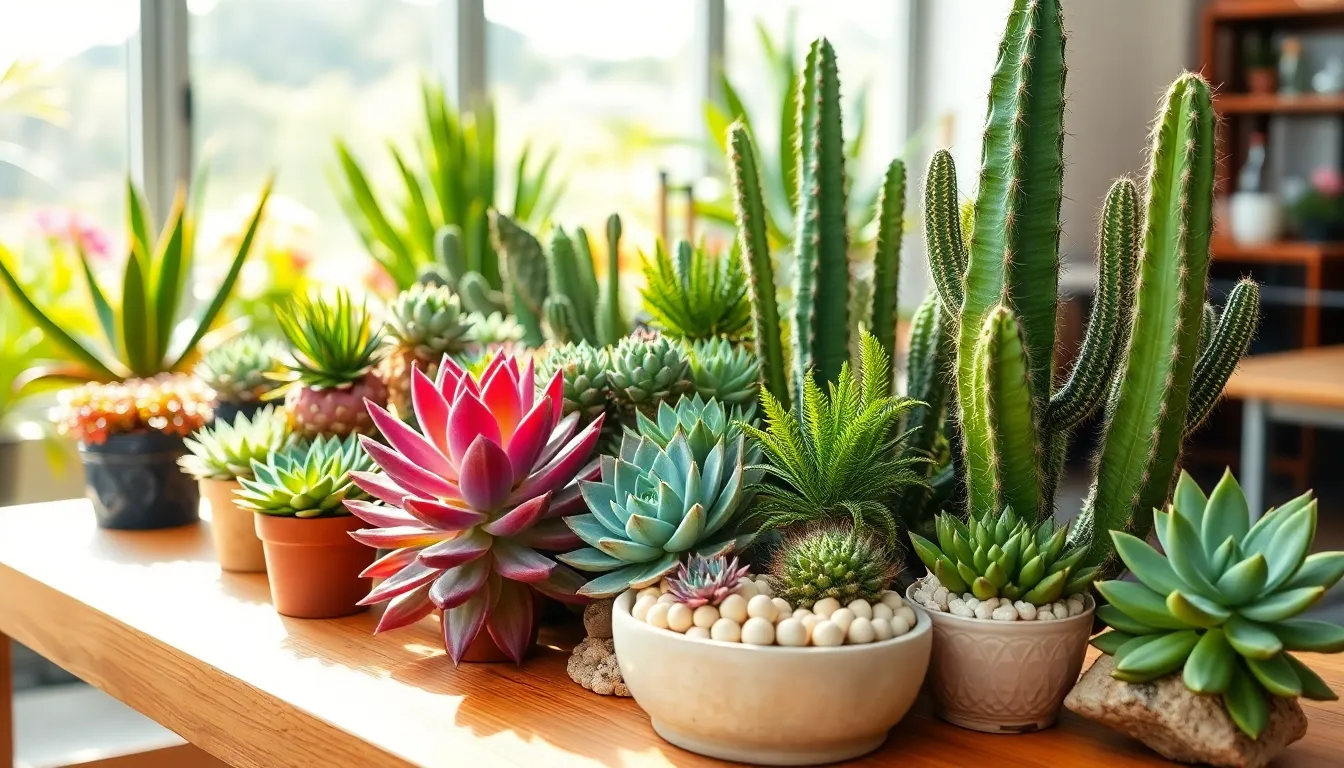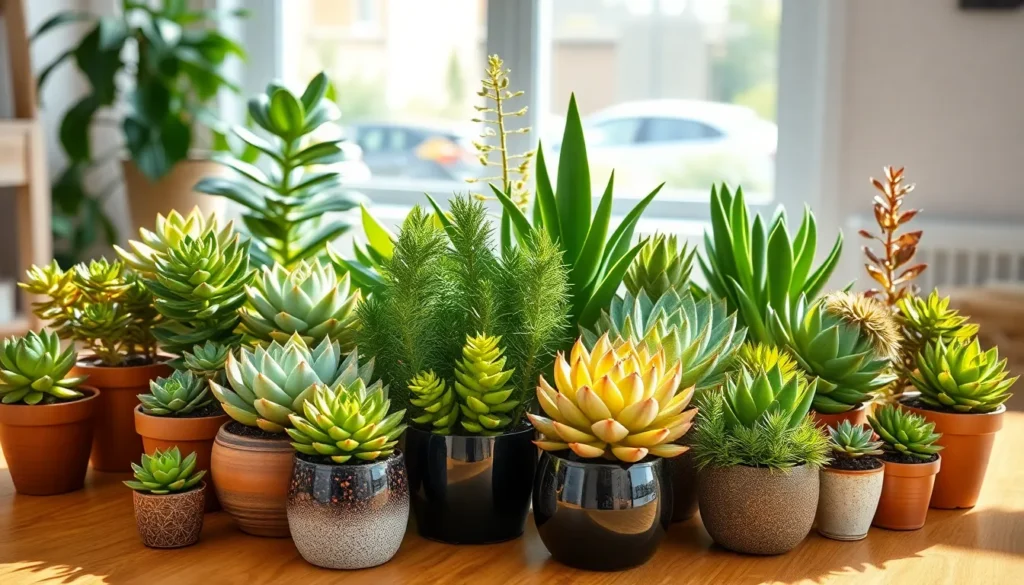Succulent plants are the ultimate low-maintenance companions for anyone who dreams of a lush indoor garden without the fuss. These quirky little greens, with their plump leaves and charming shapes, add a touch of personality to any space. It’s like having a pet that doesn’t require feeding or walking—just a little sunlight and a sip of water now and then.
Table of Contents
ToggleOverview of Succulent Plants
Succulent plants belong to a diverse group of species known for their distinctive water-storing capabilities. They thrive in arid environments, which contributes to their popularity as houseplants. Numerous varieties exist, including aloe vera, echeveria, and jade plants. Their unique characteristics, such as fleshy leaves and vibrant colors, attract both novice and experienced gardeners.
Light requirements for succulents vary, but most prefer bright, indirect sunlight. Some can tolerate direct sun while others flourish in filtered light. Watering practices also differ; these plants typically require infrequent watering due to their ability to store moisture. Overwatering often leads to root rot, making proper care crucial for healthy growth.
Succulents can adapt to various potting mediums, though well-draining soil is essential. Combine potting soil with sand or perlite for optimal drainage. Temperature tolerance is another aspect to note; succulents generally prefer warmer climates but can adapt to cooler environments as long as temperatures remain above freezing.
Certain succulents also produce stunning flowers, adding further visual interest. Flowering often occurs in the spring and summer, enhancing indoor spaces. With minimal maintenance, these plants serve as beautiful, low-effort additions to home and office settings.
Growing succulents indoors enhances air quality in living spaces. Studies suggest that indoor plants, including succulents, can absorb toxins and improve overall well-being. Regular care and attention promote longevity, making succulents rewarding plants for any gardener.
Popular Types of Succulent Plants

Succulent plants come in a variety of types, each with its unique attributes. Below are two of the most popular categories among succulent enthusiasts.
Cacti
Cacti stand out for their diverse shapes and sizes. These plants store water in their flesh, allowing them to thrive in arid conditions. Spines instead of leaves help minimize water loss. Many cacti produce vibrant flowers, especially during blooming seasons. Varieties like the Saguaro or the Christmas Cactus capture the attention of growers. Sunlight is essential, with most cacti favoring bright, direct light. Regular inspection helps prevent pests, ensuring healthy growth over time.
Echeveria
Echeveria plants showcase rosette shapes and vibrant colors. Their fleshy leaves often range from green to deep purple. These succulents adapt well to various light conditions but prefer indirect sunlight. Echeveria is known for its low watering needs, which helps prevent root rot. Popular varieties include Echeveria elegans and Echeveria ‘Black Prince.’ Seasonal blooms produce striking flowers that attract pollinators. They make excellent choices for decorative arrangements both indoors and outdoors.
Care Requirements for Succulent Plants
Succulent plants thrive with specific care requirements that ensure their health and beauty in any indoor setting. Understanding these needs helps maximize their appeal.
Watering Guidelines
Watering succulents requires careful attention to their unique moisture-retaining abilities. Infrequent watering works best, typically every two to three weeks during the growing season. Allowing the soil to dry out completely between waterings prevents root rot. Overwatering can quickly lead to serious issues; thus, it’s essential to monitor the moisture level closely. During dormancy in winter, reduce watering frequency even further. Using pots with drainage holes promotes proper water flow, aiding in optimal root health.
Light Preferences
Light exposure plays a crucial role in succulent care. Most succulents thrive in bright, indirect sunlight, nurturing their vibrant colors and unique shapes. Placing them near a window that receives filtered light fosters ideal growth conditions. Some varieties tolerate direct sunlight but excessive exposure can cause leaf scorching. Ideal locations include east or west-facing windows, where light is abundant but not overwhelming. Adjusting the position of succulents based on seasonal light changes optimizes their light intake, ensuring continued health and vitality.
Benefits of Growing Succulent Plants
Growing succulent plants offers numerous advantages, especially for indoor gardening enthusiasts. They require minimal care, making them suitable for busy individuals. Their unique water-storing abilities allow them to thrive with infrequent watering, saving time and water.
Increasing air quality represents another significant benefit. Succulents absorb toxins, contributing to a healthier indoor environment. With clean air, individuals may experience improved well-being and productivity.
Aesthetic appeal enhances any space. Succulents come in various colors, shapes, and sizes. They create eye-catching arrangements that suit diverse decor styles, from modern to rustic.
Furthermore, these plants adapt well to different light conditions. While most prefer bright, indirect sunlight, certain varieties tolerate lower light levels. This adaptability makes them ideal for locations with varying lighting.
Additionally, succulent plants offer resilience against neglect. They forgive occasional missed watering. Homeowners appreciate their ability to bounce back from minor care missteps.
Some succulents bloom beautifully, adding seasonal interest to spaces. Flowering varieties, like Echeveria, produce vibrant blooms that enhance visual appeal during spring and summer. These flowering moments are often a delightful surprise for caregivers.
Cost-effectiveness also highlights the benefits of growing succulents. Generally, they possess lower associated care costs. Their ability to proliferate means gardeners can easily propagate new plants, expanding their collection without significant investment.
The benefits of growing succulent plants include low maintenance, air purification, aesthetic versatility, adaptability, resilience, beautiful blooms, and cost-efficiency. Embracing these plants can transform any home or office into a more inviting and vibrant space.
Style Ideas for Incorporating Succulent Plants
Using succulent plants enhances visual appeal in various settings. First, consider using a terrarium for creating a miniature garden environment. This closed system retains humidity, making it ideal for small succulents.
Another option involves using wall-mounted planters to display succulents vertically. These installations save floor space while adding a touch of greenery to walls. They work well in both homes and offices, infusing life into otherwise bare areas.
Grouping succulents in clusters creates an eye-catching centerpiece. Different shapes and colors add dimension to coffee tables or dining areas. Arranging them in decorative trays or bowls emphasizes their unique characteristics while keeping maintenance simple.
For outdoor spaces, succulent arrangements in pots or borders make an attractive landscape feature. Mix various types like cacti and echeveria to complement pathways or patios. Choosing pots in an array of materials and colors enhances overall design.
Hanging planters also provide an innovative way to incorporate succulents. Suspended from ceilings or hooks, these plants add depth and interest to gardens or patios. Selecting trailing varieties like string of pearls enhances the visual effect.
Integrating succulents into home decor can improve both aesthetics and air quality. Incorporate them into bookcases or desks for a touch of nature. These plants naturally filter indoor air pollutants, promoting a healthier living environment.
Using succulents in seasonal displays offers a simple method to refresh decor. For example, placing them with holiday ornaments creates themed decorations. Their versatility ensures they complement various styles, from modern to rustic.
Succulent plants offer a unique blend of beauty and practicality for any indoor or outdoor space. Their low-maintenance nature and striking appearances make them perfect for busy individuals and novice gardeners alike. With the right care and attention to light and watering needs, these resilient plants can thrive and enhance the aesthetic of any environment.
Whether creating a vibrant terrarium or adding clusters to a sunny windowsill, succulents provide endless opportunities for creativity. Their ability to purify the air and adapt to various decor styles further solidifies their status as a beloved choice among plant enthusiasts. Embracing succulents is not just about gardening; it’s about bringing life and vitality into everyday spaces.

